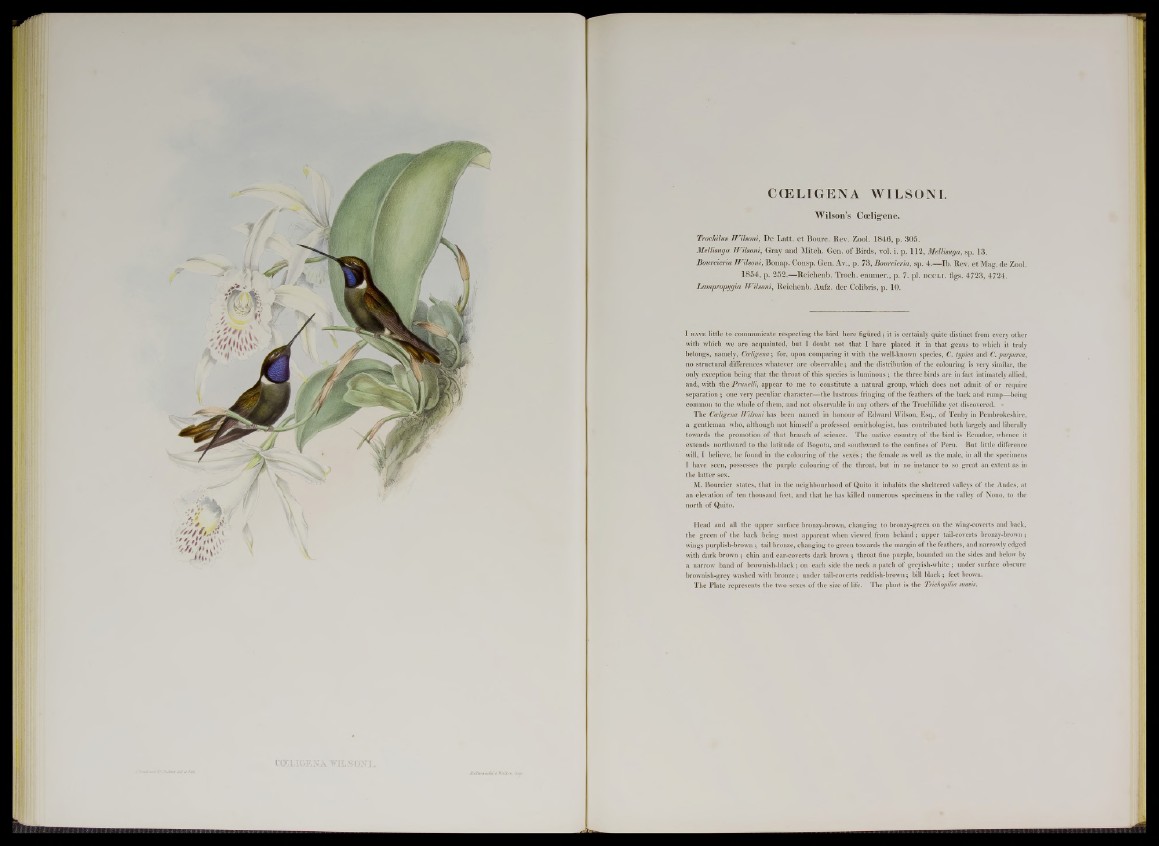
CCELIGENA WILSONI .
Wilson’s Coelig'ene.
Trochilus Wilsoni, De L a tt. e t Bourc. Rev. Zool. 1846, p. 305.
Mellisuga Wilsoni, Gray and Mitch. Gen. o f Birds, vol. i. p. 112, Mellisuga, sp. 13.
Bourcieria Wilsoni, Bonap. Consp. Gen. Av., p. 73, Bourcieiia, sp. 4.— lb . Rev. e t Mag. de Zool.
1854, p. 252.— Reicbenb. Troch. enumer., p. 7. pi. d c c l i . figs. 4723, 4724.
Lampropygia Wilsoni, Reichenb. Aufiz. der Colibris, p. 10.
I h a v e little to communicate respecting the bird here figured; it is certainly quite distinct from every other
with which we are acquainted, but I doubt not that I have placed it in that genus to which it truly
belongs, namely, Coeligena; for, upon comparing it with the well-known species, C. typica and C. purpurea,
no structural differences whatever are observable; and the distribution of the colouring is very similar, the
only exception being that the throat of this species is luminous ; the three birds are in fact intimately allied,
and, with the Primelli, appear to me to constitute a natural group, which does not admit of or require
separation ; one very peculiar character—the lustrous fringing of the feathers of the back and rump—being
common to the whole of them, and not observable in any others of the Trochilidae yet discovered. •
The Coeligena Wilsoni has been named in honour of Edward Wilson, Esq., of Tenby in Pembrokeshire,
a gentleman who, although not himself a professed ornithologist, has contributed both largely and liberally
towards the promotion of that branch of science. The native country of the bird is Ecuador, whence it
extends northward to the latitude of Bogota, and southward to the confines of Peru. But little difference
will, I believe, be found in the colouring of the sexes; the female as well as the male, in all the specimens
I have seen, possesses the purple colouring of the throat, but in no instance to so great an extent as in
the latter sex.
M. Bourcier states, that in the neighbourhood of Quito it inhabits the sheltered valleys of the Andes, at
an elevation of ten thousand feet, and that he has killed numerous specimens in the valley of Nono, to the
north of Quito.
Head and all the upper surface bronzy-brown, changing to bronzy-green on the wing-coverts and back,
the green of the back being most apparent when viewed from behind; upper tail-coverts bronzy-brown;
wings purplish-brown; tail bronze, changing to green towards the margin of the feathers, and narrowly edged
with dark brown ; chin and ear-coverts dark brown ; throat fine purple, bounded on the sides and below by
a narrow band of brownish-black; on each side the neck a patch of greyish-white ; under surface obscure
brownish-grey washed with bronze; under tail-coverts reddish-brown; bill black; feet brown.
The Plate represents the two sexes of the size of life. The plant is the Trichopilia suavis.